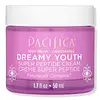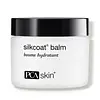What's inside
What's inside
 Key Ingredients
Key Ingredients

 Benefits
Benefits

 Concerns
Concerns

 Ingredients Side-by-side
Ingredients Side-by-side

Water
Skin ConditioningHelianthus Annuus Seed Oil
EmollientMyristyl Myristate
EmollientIsopropyl Myristate
EmollientC12-15 Alkyl Benzoate
AntimicrobialButyrospermum Parkii Butter
Skin ConditioningStearic Acid
CleansingGlyceryl Stearate Citrate
EmollientGlycerin
HumectantPalmitoyl Tripeptide-5
Skin ConditioningDipeptide Diaminobutyroyl Benzylamide Diacetate
Skin ConditioningPropanediol
SolventGlyceryl Stearate
EmollientSodium Stearoyl Glutamate
CleansingCetyl Alcohol
EmollientStearyl Alcohol
EmollientBetaine
HumectantArginine
MaskingSodium PCA
HumectantHibiscus Sabdariffa Flower Extract
Skin ConditioningIris Pallida Leaf Cell Extract
AntioxidantRosa Damascena Flower Water
MaskingPelargonium Graveolens Oil
MaskingDibutyl Lauroyl Glutamide
Skin ConditioningTocopheryl Acetate
AntioxidantXanthan Gum
EmulsifyingPhenoxyethanol
PreservativeEthylhexylglycerin
Skin ConditioningWater, Helianthus Annuus Seed Oil, Myristyl Myristate, Isopropyl Myristate, C12-15 Alkyl Benzoate, Butyrospermum Parkii Butter, Stearic Acid, Glyceryl Stearate Citrate, Glycerin, Palmitoyl Tripeptide-5, Dipeptide Diaminobutyroyl Benzylamide Diacetate, Propanediol, Glyceryl Stearate, Sodium Stearoyl Glutamate, Cetyl Alcohol, Stearyl Alcohol, Betaine, Arginine, Sodium PCA, Hibiscus Sabdariffa Flower Extract, Iris Pallida Leaf Cell Extract, Rosa Damascena Flower Water, Pelargonium Graveolens Oil, Dibutyl Lauroyl Glutamide, Tocopheryl Acetate, Xanthan Gum, Phenoxyethanol, Ethylhexylglycerin
Water
Skin ConditioningGlycerin
HumectantButyrospermum Parkii Butter
Skin ConditioningCaprylic/Capric Triglyceride
MaskingCetyl Alcohol
EmollientGlyceryl Stearate
EmollientCyclopentasiloxane
EmollientDimethicone
EmollientTheobroma Cacao Seed Butter
EmollientC12-15 Alkyl Benzoate
AntimicrobialStearic Acid
CleansingPotassium Cetyl Phosphate
EmulsifyingCetearyl Alcohol
EmollientPhenoxyethanol
PreservativePolysorbate 60
EmulsifyingAllantoin
Skin ConditioningSimmondsia Chinensis Seed Oil
EmollientSqualane
EmollientTocopheryl Acetate
AntioxidantHydrolyzed Silk
HumectantAcrylates/C10-30 Alkyl Acrylate Crosspolymer
Emulsion StabilisingEthylhexylglycerin
Skin ConditioningHydrastis Canadensis Extract
MaskingLavandula Angustifolia Flower Extract
CleansingRosmarinus Officinalis Leaf Extract
AntimicrobialThymus Vulgaris Flower/Leaf Extract
MaskingSodium Hydroxide
BufferingWater, Glycerin, Butyrospermum Parkii Butter, Caprylic/Capric Triglyceride, Cetyl Alcohol, Glyceryl Stearate, Cyclopentasiloxane, Dimethicone, Theobroma Cacao Seed Butter, C12-15 Alkyl Benzoate, Stearic Acid, Potassium Cetyl Phosphate, Cetearyl Alcohol, Phenoxyethanol, Polysorbate 60, Allantoin, Simmondsia Chinensis Seed Oil, Squalane, Tocopheryl Acetate, Hydrolyzed Silk, Acrylates/C10-30 Alkyl Acrylate Crosspolymer, Ethylhexylglycerin, Hydrastis Canadensis Extract, Lavandula Angustifolia Flower Extract, Rosmarinus Officinalis Leaf Extract, Thymus Vulgaris Flower/Leaf Extract, Sodium Hydroxide
Ingredients Explained
These ingredients are found in both products.
Ingredients higher up in an ingredient list are typically present in a larger amount.
This ingredient is also known as shea butter. It is an effective skin hydrator and emollient.
Emollients help soothe and soften your skin. It does this by creating a protective film on your skin. This barrier helps trap moisture and keeps your skin hydrated. Emollients may be effective at treating dry or itchy skin.
Shea butter is rich in antioxidants. Antioxidants help fight free-radicals, or molecules that may harm the body. It is also full of fatty acids including stearic acid and linoleic acid. These acids help replenish the skin and keep skin moisturized.
While Shea Butter has an SPF rating of about 3-4, it is not a sunscreen replacement.
Shea butter may not be fungal acne safe. We recommend speaking with a professional if you have any concerns.
Learn more about Butyrospermum Parkii ButterC12-15 Alkyl Benzoate is made up of Benzoic Acid and long chain alcohols. It has a low molecular weight.
C12-15 Alkyl Benzoate is an emollient and texture enhancer. Due to its solubility, it is often used in sunscreens to help evenly distribute active ingredients.
As an emollient, C12-15 Alkyl Benzoate helps soften and hydrate your skin. Emollients create a film on your skin that traps moisture within.
This ingredient has been reported to cause eye irritation.
Learn more about C12-15 Alkyl BenzoateCetyl Alcohol is a fatty alcohol. Fatty Alcohols are most often used as an emollient or to thicken a product.
Its main roles are:
Though it has "alcohol" in the name, it is not related to denatured alcohol or ethyl alcohol.
The FDA allows products labeled "alcohol-free" to have fatty alcohols.
Learn more about Cetyl AlcoholEthylhexylglycerin (we can't pronounce this either) is commonly used as a preservative and skin softener. It is derived from glyceryl.
You might see Ethylhexylglycerin often paired with other preservatives such as phenoxyethanol. Ethylhexylglycerin has been found to increase the effectiveness of these other preservatives.
Glycerin is already naturally found in your skin. It helps moisturize and protect your skin.
A study from 2016 found glycerin to be more effective as a humectant than AHAs and hyaluronic acid.
As a humectant, it helps the skin stay hydrated by pulling moisture to your skin. The low molecular weight of glycerin allows it to pull moisture into the deeper layers of your skin.
Hydrated skin improves your skin barrier; Your skin barrier helps protect against irritants and bacteria.
Glycerin has also been found to have antimicrobial and antiviral properties. Due to these properties, glycerin is often used in wound and burn treatments.
In cosmetics, glycerin is usually derived from plants such as soybean or palm. However, it can also be sourced from animals, such as tallow or animal fat.
This ingredient is organic, colorless, odorless, and non-toxic.
Glycerin is the name for this ingredient in American English. British English uses Glycerol/Glycerine.
Learn more about GlycerinGlyceryl Stearate is a mix of glycerin and stearic acid.
It is used to stabilize the mixing of water and oil ingredients. By preventing these ingredients from separating, it can help elongate shelf life. It can also help thicken the product's texture.
As an emollient, it helps soften skin and supports barrier-replenishing ingredients.
In cosmetics, Glyceryl Stearate is often made from vegetable oils or synthetically produced.
This ingredient may not be fungal-acne safe
Fun fact: The human body also creates Glyceryl Stearate naturally.
Learn more about Glyceryl StearatePhenoxyethanol is a preservative that has germicide, antimicrobial, and aromatic properties. Studies show that phenoxyethanol can prevent microbial growth. By itself, it has a scent that is similar to that of a rose.
It's often used in formulations along with Caprylyl Glycol to preserve the shelf life of products.
Stearic Acid is a fatty acid. It is an emollient, emulsifier, and texture enhancer.
As an emollient, stearic acid helps soften skin. It aids the skin's protective barrier by preventing water loss. It also provides a gentle cleansing effect without stripping away natural oils.
Stearic acid may also be used to enhance the texture of products. It can add volume and stabilize ingredients such as water and oil. This can help water and oil ingredients from separating.
Sources of stearic acid include animal or vegetable fats/oils such as coconut or shea. It can be naturally found in butter, cocoa butter, shea butter, vegetable fats, and animal tallow.
This ingredient may not be Malassezia folliculitis, or fungal-acne safe.
Learn more about Stearic AcidTocopheryl Acetate is AKA Vitamin E. It is an antioxidant and protects your skin from free radicals. Free radicals damage the skin by breaking down collagen.
One study found using Tocopheryl Acetate with Vitamin C decreased the number of sunburned cells.
Tocopheryl Acetate is commonly found in both skincare and dietary supplements.
Learn more about Tocopheryl AcetateWater. It's the most common cosmetic ingredient of all. You'll usually see it at the top of ingredient lists, meaning that it makes up the largest part of the product.
So why is it so popular? Water most often acts as a solvent - this means that it helps dissolve other ingredients into the formulation.
You'll also recognize water as that liquid we all need to stay alive. If you see this, drink a glass of water. Stay hydrated!
Learn more about Water